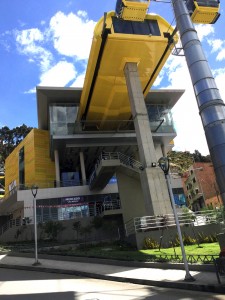Our Director of International Programs, Luis Bourdet, and I flew into La Paz just before sunrise, after an overnight trip from Richmond. I was woozy from fatigue or the elevation — 13,000 feet above sea level — and grateful when a young woman woke up at 4 am to check us into our hotel.
A City in the Mountains
I woke up as the sun rose, and got my first view of an amazing vertical city. I’ve never seen anywhere else like it; skyscrapers and colonial architecture sit unevenly, side-by-side, built on the hills that once made this city so difficult to navigate. Bridges, new since Luis’ last trip here, have made connections that never existed over ravines and valleys, letting even the poorest residents make trips that were once impossible.
 Not every place is accessible by bridge though, and automobile traffic is congested and slow. Many residents still walk because they can’t afford a car or to avoid congestion. The city introduced a cable car system in 2014 to address their needs. This system, Mi Teleférico, connects La Paz with its poorer neighbor, El Alto, the highest major city in the world, built another 1,500 feet up the mountains.
Not every place is accessible by bridge though, and automobile traffic is congested and slow. Many residents still walk because they can’t afford a car or to avoid congestion. The city introduced a cable car system in 2014 to address their needs. This system, Mi Teleférico, connects La Paz with its poorer neighbor, El Alto, the highest major city in the world, built another 1,500 feet up the mountains.
La Paz is impoverished, but El Alto is also a grim place, home to recently dispossessed farming families fleeing drought and famine. The families are primarily from indigenous backgrounds, and they face additional hardships seeking jobs and opportunities. Until Mi Teleférico, they were only connected to opportunities in the more prosperous city below by slow buses on long, winding roads.
The cable cars were designed to cost less than the buses, and are powered by the sun. Residents use them to get to the sprawling markets in El Alto, and tourists use them for the stunning views of the cities below.
The image of those cable cars and the bridges lingers long after I first saw them. I keep reflecting on how this infrastructure, a gift from the state government, has empowered so many people and changed their lives so dramatically.
We visit neighborhoods that Luis remembers from his last trip, before the bridge, and he remarks on the improvements. Unsteady brick shacks have been upgraded into sturdy concrete homes, safer and more stable over the soft soil and steep slopes they are built on.
I am reminded that it is often the simplest thing, like building a bridge—or sponsoring a child—that can make all the difference.
Parts of La Paz may just as well have been on the moon for those without the means to drive. Now, three bridges and these amazing cable carts in the sky connect the city. I am reminded that it is often the simplest thing, like building a bridge—or sponsoring a child—that can make all the difference.
Exploring Pedro Poveda
Of course, we didn’t visit these sites alone. Josefina, our volunteer coordinator, gave us a tour of the city, showing us some of the highlights and attractions. At a bustling market, we ran into two children sponsored through Children Incorporated, Daniel and Nicole, who rushed up to kiss and hug Josefina.
The children’s mother owns a small tienda at the market—a tin shack where she prepares breakfast 7 days a week. By day, the children’s father works as a taxi driver. Their mother works a second shift as a taxi driver after the market closes every evening.
After exchanging money at a local bank, we went to Pedro Poveda. Like everything here, the school is built on a hill, and there are many stairs that lead up to the classrooms. We first visited students in a carpentry class, who are learning the trade. We also visited students in an electronics class working on small electronics like radios, and then a cooking class, where students were learning to combine local food with their meals — pasta with local spinach, or other vegetables.
After, we visited the community center directly across from the school, where Josefina had been the principal of for 15 years. Originally a library, she helped transform the center into an after-school program for students who have parents who work long hours, or suffer from complex behavioral problems and need extra support and love.
The room was filled with children busily working on homework or teaching games. Local university students volunteer their time as after-school tutors. After homework is done, the children are invited to the playroom for crafts and games.
***
HOW DO I SPONSOR A CHILD IN BOLIVIA?
You can sponsor a child in Bolivia in one of three ways – call our office and speak with one of our sponsorship specialists at 1-800-538-5381, email us at sponsorship@children-inc.org, or go online to our donation portal, create an account, and search for a child in Bolivia that is available for sponsorship.
